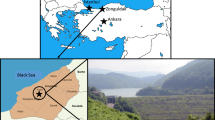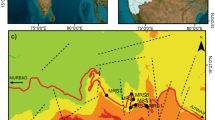Abstract
Turkey has many cave formations and some caves are important tourist attractions. Theses caves have natural and historical characteristics that need to be investigated and protected. An important rock engineering topic is the identification of possible rock falls and collapses in caves that are open to the public and planning preventive measures. In this study, the locations and types of instability problems were identified along a section of 875 m of the Gökgöl cave in Zonguldak, Turkey. The main instabilities were identified as block falls controlled by discontinuities, rock block sliding, and flexural toppling. To obtain the intact rock and rock mass properties of the stratified limestone which is the host rock of the cave, field and laboratory studies were conducted. Stability assessments for four different sections inside the cave were carried out using numerical and analytical methods, and the results were compared. The results of the analyses revealed that some countermeasures and precautions must be implemented to increase the stability in some areas of the Gökgöl cave, especially those which have potential for regional failure.




























Similar content being viewed by others
References
Aydan Ö (1989) The stabilization of rock engineering structures by rockbolts. Doctorate Thesis, Nagoya University, p 204
Aydan Ö (2000) A new stress inference method for the stress state of Earth’s crust and its application. Yerbilimleri 22:223–236 (in Turkish)
Aydan Ö (2011) Personal communication. (Formerly with Tokai University, Shizuoka, Japan; Presently the University of Ryukyus, Nishihara, Japan) Ocean Research Institute
Aydan Ö (2012) Personal communication. (Formerly with Tokai University, Shizuoka, Japan; Presently the University of Ryukyus, Nishihara, Japan) Ocean Research Institute
Aydan Ö, Dalgıç S (1998) Prediction of deformation behaviour of 3 lanes Bolu tunnels through squeezing rocks of North Anotolian fault zone (NAFZ). In: proceedings of the regional symposium on sedimentary rock engineering, Taipei, pp 228–33
Aydan Ö, Kawamoto T (1992) Stability of slopes and underground openings against flexural toppling and their stabilization. Rock Mech Rock Eng 25(3):143–165
Aydan Ö, Tokashiki N (2011) A comparative study on the applicability of analytical stability assessment methods with numerical methods for shallow natural underground openings. In: the 13th international conference of the International Association for Computer Methods and Advances in Geomechanics, Melbourne, Australia, pp 964–969
Aydan Ö, Ulusay R, Kawamoto T (1997) Assessment of rock mass strength for underground excavations. In: Proceedings of the 36th US rock mechanics symposium, pp 777–786
Aydan Ö, Geniş M, Tokashiki N (2009) The stability assessment of karstic caves beneath Gushikawa Castle remains (Japan). In: Vrjklan I (ed) EUROCK2009 ISRM regional symposium—rock engineering in difficult ground conditions-soft rocks and karst. Dubrovnik,Croatia, pp 449–454
Aydan Ö, Tokashiki N, Geniş M (2011) Stability assessment of Himeyuri monument and adjacent karstic cave. In: Kulaksız S, Tuncay E (eds) proceedings of the KAYAMEK’2011-Xth Regional rock mechanics symposium, Ankara, Turkey, pp 39–46
Aydan Ö, Geniş M, Tokashiki N (2012) Some considerations on yield (failure) criteria in rock mechanics. In: 46th US Rock mechanics/geomechanics Symposium, Chicago, USA, ARMA 12, p 640 (full paper on CD)
Barton N (1972) A model study of rock-joint deformation. Int J Rock Mech Min Sci Geomech Abstr 9(5):579–602
Barton N (1995) The influence of joint properties in modelling jointed rock masses. Keynote Lecture, 8th ISRM Congress, vol 3. Balkema, Rotterdam, Tokyo, pp 1023–1032
Barton N (2002) Some new Q value correlations to assist in site characterization and tunnel design. Int J Rock Mech Min Sci 39:185–216
Barton N, Bandis SC (1990) Review of predictive capabilities of JRC-JCS model in engineering practice. In: proceedings international symposium on Rock Joints, Balkema, Loen, Norway, Rotterdam, pp 603–610
Barton N, Choubey V (1977) The shear strength of rock joints in theory and practice. Rock Mech 10(1–2):1–54
Barton N, Lien R, Lunde I (1974) Engineering classification of rock masses for the design of tunnel support. Rock Mech 6(4):189–239
Bieniawski ZT (1973) Engineering classification of jointed rock masses. Trans S Afr Inst Civ Eng 15(12):335–344
Bieniawski ZT (1989) Engineering rock mass classifications. Wiley, New York
Çolak B (2012) Assessment of the Gökgöl cave stability with analytical and numerical analysis methods. Bülent Ecevit University, Graduate School of Natural and Applied Sciences, M.Sc. Thesis, Zonguldak, Turkey, p 185
Deere DU, Miller DW (1967) The rock quality designation (RQD) index in practice, classification systems for engineering purposes. ASTM STP, American Society for Testing and Materials, Philadelphia, pp 91–101
Grimstad E, Barton N (1993) Updating the Q-system for NMT. In: proceedings on international symposium on sprayed concrete, Fagernes, Norway. Norwegian Concrete Association, Oslo, Norway, p 20
Hoek E, Brown ET (1997) Practical estimates of rock mass strength. Int J Rock Mech Min Sci 34(8):1165–1186
Hoek E, Diederichs MS (2006) Empirical estimation of rock mass modulus. Int J Rock Mech Min Sci 43:203–215
Hoek E, Kaiser PK, Bawden WF (1995) Support of underground excavations in hard rock. Balkema, Rotterdam, p 214
ISRM (2007) The complete ISRM suggested methods for rock characterization, testing and monitoring: 1974–2006. In: Ulusay R, Hudson JA (eds) Suggested methods prepared by the ISRM commission on testing methods, compilation arranged by the ISRM Turkish National Group. Kozan Ofset, Ankara, p 628
Kopar İ (2010) A new record from the fossilized cave potential in the Aladağ Mountain range (Central Tauride Belt): the Kapuzbaşı Cave (Mount Divrik). Türk Coğrafya Dergisi. İstanbul, vol 54, pp 31–42 (in Turkish)
Mitri HS, Edrissi R, Henning J (1994) Finite element modelling of cable-bolted stopes in hardrock ground mines. In: SME Annual Meeting, New Mexico, pp 94–116
MTA (2012) Map on karst area of Turkey. Mineral Research and Exploration General Directorate of Turkey. http://www.mta.gov.tr/v2.0/daire-baskanliklari/jed/index.php?id=karst_magara
Nazik L (1989) Geological and geomorphological and ecological characteristics determined by the morphology of the cave. Jeomorfoloji Dergisi Ankara 17:53–62 (in Turkish)
Nazik L, Mengi H, Özel E, Bircan A, Beydeş S (1995) Natural caves around Zonguldak. Mineral Research and Exploration General Directorate of Turkey (MTA), Report no: 9764, Ankara (in Turkish)
Nazik L, Törk K, Tuncer K, Özel E, İnan H, Savaş F (2005) Caves of Turkey. In: proceedings of Symposium on National Cave Days, Konya, Turkey, pp 31–46 (in Turkish)
Nicholson GA, Bieniawski ZT (1990) A nonlinear deformation modulus based on rock mass classification. Int J Min Geol Eng 8:181–202
Özler İ, Tongal O, Canca N, Kır N, Yaver Y, Bakan Z (1992) Geology and coal occurance of Zonguldak district between Değirmenağzı and Göbü. Mineral Research and Exploration General Directorate of Turkey, Report no: 9599, vol 1, Ankara (in Turkish)
Palmström A (1982) The volumetric joint count—a useful and simple measure of the degree of jointing. In: IVth International Congress IAEG, New Delhi, India, pp 221–228
Palmström A (2000) Recent developments in rock support estimates by the RMi. J Rock Mech Tunn Technol 6:1–19
Palmström A, Singh R (2001) The deformation modulus of rock masses-comparisons between in situ tests and indirect estimates. Tunn Undergr Space Technol 16:115–131
Read SAL, Richards LR, Perrin ND (1999) Applicability of the Hoek–Brown failure criterion to New Zealand greywacke rocks. In: Proceedings on 9th International Congress on Rock Mechanics Paris, France, vol 2, pp 655–660
Rocscience (2011a) DIPS (ver. 5.1): graphical and statistical analysis of orientation data. Toronto, Canada. http://www.rocscience.com
Rocscience (2011b) PHASE2 (ver. 6.014): finite element analysis for excavations and slopes. Toronto, Canada. http://www.rocscience.com
Santo A, Prete S, Crescenco G, Rotella M (2007) Karst processes and slope instability: some investigations in the carbonate Apennine of Campania (southern Italy). In: Natural and anthropogenic hazards in karst areas: recognition, analysis and mitigation, vol 279, pp 59–72
Serafim JL, Pereira JP (1983) Consideration of the geomechanics classification of Bieniawski. In: Proceedings on International Symposium on Engineering Geology Underground Construction, Lisbon, Portugal, pp 1133–1144
Sönmez H, Ulusay R (2007) Engineering properties of rock masses, 2nd edn. vol 60. TMMOB Chamber of Geological Engineers of Turkey, Ankara, p 292 (in Turkish)
Sönmez H, Gökçeoğlu C, Nefeslioğlu HA, Kayabaşı A (2006) Estimation of rock modulus: for intact rocks with an artificial neural network and for rock masses with a new empirical equation. Int J Rock Mech Min Sci 43:224–235
Szunyogh G (2010) Stability assessment of caves and its results. Óbuda Univ e-Bull 1(1):243–251
Waltham AC, Fookes PG (2005) Engineering classification of karst ground conditions. Speleogenesis and evolution of karst aquifers, 3(1). www.speleogenesis.info, p 20, re-published from Quartely Journal of Engineering Geology and Hydrogeology. 2003, 36:101–118
Acknowledgments
The authors wish to express their deep gratitude to Prof. Ömer Aydan (University of the Ryukyus, Japan) for his valuable suggestions and help at the study site and the in the laboratory and to Prof. Hasan Gerçek (Bülent Ecevit University, Turkey) and Dr. Özgü Kaşmer (Ministry of Environment and Urbanization, Turkey) for their help with the English edition of this paper. In addition, we gratefully acknowledge the Scientific Research Unit of Bülent Ecevit University for providing financial support (Project No: 2011-17-11-05).
Author information
Authors and Affiliations
Corresponding author
Rights and permissions
About this article
Cite this article
Geniş, M., Çolak, B. Stability Assessment of the Gökgöl Karstic Cave (Zonguldak, Turkey) by Analytical and Numerical Methods. Rock Mech Rock Eng 48, 2383–2403 (2015). https://doi.org/10.1007/s00603-014-0700-z
Received:
Accepted:
Published:
Issue Date:
DOI: https://doi.org/10.1007/s00603-014-0700-z




